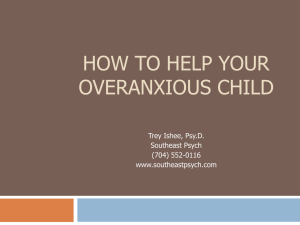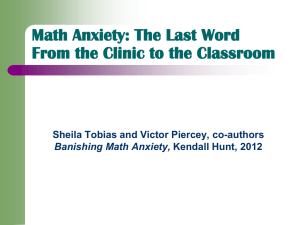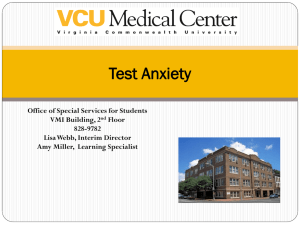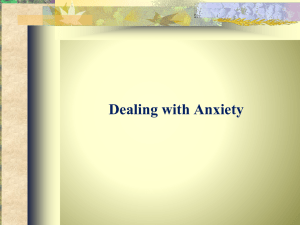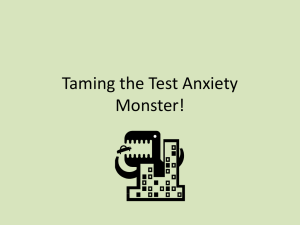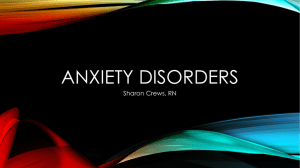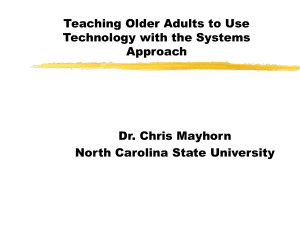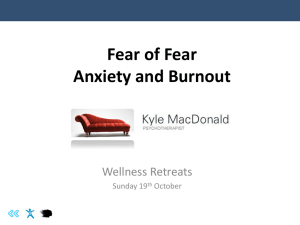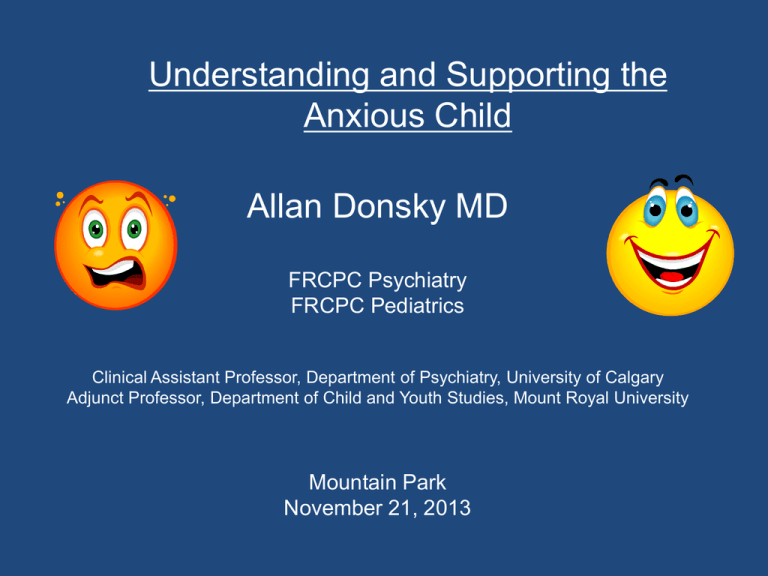
Understanding and Supporting the
Anxious Child
Allan Donsky MD
FRCPC Psychiatry
FRCPC Pediatrics
Clinical Assistant Professor, Department of Psychiatry, University of Calgary
Adjunct Professor, Department of Child and Youth Studies, Mount Royal University
Mountain Park
November 21, 2013
Learning Objectives
• What is anxiety ?
• Can Anxiety be “normal” ?
• How does it arise ?
• What does Anxiety look like ?
• What can I do about it ?
Common Age Related Fears
Birth-6 Months
Loud noise, loss of physical support, rapid position
changes, rapidly moving objects
7-12 Months
Strangers, looming objects, sudden unexpected
objects or unfamiliar people
1-5 Years
Strangers, storms, animals, dark, separation from
parents, loud noise, toilet, monsters, ghosts,
insects, bodily harm
6-12 Years
Supernatural beings, bodily injury,
disease, burglars, staying alone, failure, criticism,
punishment
What do children have to worry about ?
School Related Fears
•
•
•
•
•
•
•
•
•
Separation from home
Bus
Performance anxiety
Academics
Interacting with peers or teachers
Bullied
Eating in front of others
Using the bathroom
Changing for gym
7
The most Challenging Decade in life
•
•
•
•
•
•
•
•
Sex
Money
Future
Identity
Academics
Independence
Sexual Orientation
Social Competence
General Principles
• Root word : Anxious, Anger, Anguish = Torment
• Anxiety can be a Symptom or a Disorder.
• Synonyms : apprehension, anguish, unease,
concern, nervous, misgiving, qualm, disquiet,
distress, dread , distraught, threatened, uneasiness,
edgy, jittery, trepidation, timid, tense, uneasy,
consternation,worry.
• Anxiety is apprehension, tension, or uneasiness from
Anticipated danger.
• Anxiety has survival value
• Impairment or distress/suffering makes it a Disorder
The Spectrum of Fear and Anxiety in
Children
Typical,
developmentally
appropriate
Severe
anxiety
symptoms
10
How common are Mental Health Disorders ?
Disorder
Estimated Prevalence %
Any Anxiety Disorder
6.4
ADHD
4.8
Conduct Disorder
4.2
Any Depressive Disorder
3.5
Substance abuse
0.8
PDD
0.3
OCD
0.2
Any Eating Disorder
0.1
Tourette Syndrome
0.1
Schizophrenia
0.1
Bipolar
<0.1
Any Disorder
14.3
Waddell, Offord et al Can J Psychiatry 2002;47(9):825-832
What about temperament ?
Arousal
Behavioral Inhibition
J Am Acad Child Adolesc Psychiatry. 1993 Jul;32(4):814-21.
How does Anxiety arise ?
Temperament
Psychological
Environment
Genetics
Anxiety +/- Disorder
Splitters and Clumpers
Family
•Insecure Attachment
•Modeling
•Stress
Media
School
Social
Trauma
Response to Anxiety
• Fright ( Experience)
• Freeze ( “ Deer in headlights” )
• Flight (Avoidance )
• Fight ( Argue, Fuss, Oppositional )
• Faint (injury)
What might Anxiety look like ?
Physiological
Cognitive
Experiential
Behavioral
Physiological
• Somatic symptoms
• Mild Panic
• Recognizable as fight or flight
• Breathing
• Heart rate
• Muscle tension
• Tummy aches
• Sleep, nightmares
• Tired
Cognitive
•
•
•
•
•
•
•
•
•
Worry is a defining feature
Attention
Concern about adult matters
Catastrophic thinking
Rigid
Hard time letting go
Struggle to make choices
Unable to see success
Negative view of self and others
Experiential
•
•
•
•
•
Dread
Sensitive
Hyper-vigilant
Low self worth
Low self esteem
Behavioral
•
•
•
•
Fight
Flight ( avoidance)
Freeze
Repetitive actions
• Nail biting, licking lips, pull hair, chew clothing, pacing
• Obsessions (repetitive thoughts) or compulsions.
• Need for reassurance, help seeking , overdependence
Why is Anxiety missed ?
• Awareness
• Internalizing
• Silence is seen as absence of problem
• Tend to normalize shyness
• Labeled as other things ( very unhelpful !! )
Labeled as other things
•
•
•
•
•
•
•
•
Oppositional
Defiant
Manipulative
Attention
seeking
Demanding
Confrontational
Sneaky
Pushes buttons
•Lazy
•Avoidant
•Selfish
•Aggravating
•Annoying
•Ignorant
•Rude
•Stubborn
The real question: “What is going on ?”
So what if there is Anxiety?
Academic
Attendance , Avoidance , Underachievement
Behavioral
Avoidance , oppositional
Cognitive
No risks, confidence, image
Developmental
Image, success, confidence,
Emotional
Stunted
Family
Power struggles, tired
Physical
Gym avoidance
Social
Loneliness, tobacco & alcohol use
Common Beliefs About Worries: All untrue
Worrying:
•
•
•
•
•
Motivates me
Helps find solutions to problems
Prevents negative outcomes
Protects me from negative emotions
Is a positive personality trait …it means I care
Francis, K. & Dugas, M. J. (2004). Assessing positive beliefs about worry: Validation of a structured
interview. Personality and Individual Differences, 37, 405-415.
Pedal , Steer and Brake
What can I do to help ?
• Treat own Anxieties
• Get Educated
• Stop
•
•
•
•
Criticism
Rescuing” – Makes it worse
Dismissing their experience
Reassuring the wrong way ( “ Don’t worry”)
• Start
• Reassuring the right way ( “ You can handle this “)
• Bravery = Support activities in spite of Anxiety
• Encourage facing new situations
Are Feelings Real ?
“My feelings are real but they don’t always tell me the
truth”
Relationship is everything
• Establish trust
• People don’t care how much you know till they know how
much you care
• Be authentic …let them see your weaknesses
• Stay calm….even if you do not know what to do !
• Act as a coach, not solver
• Recognize patterns so they can be:
• Explored
• Explained
• Expanded
• Have proactive conversations
• Use student’s ideas first and then yours
How much do I push ?
Breaking point
Peak
Performance
Rage
Lose it
Meltdown
Freak out
Over-react
Stress
Push
Back off
Life is Simple, not easy
Moments
•Education
•Relaxation
•Emotional vocabulary
“Pop ups”
Thoughts
•Coaching
•Reality check
•Evidence
•Realistic & Constructive
•Worry Thermometer
•Mastery & Pleasure
•Internal praise
•Modeling
•Social engineering
•Exposure
•Experiments
•Problem Solving
Feelings
Anxiety
Actions
Relief
Avoidance
Helpful
Unhelpful
( F words)
Perfectionism
Excellence and “ Good Enough”
• Perfectionism is unattainable = set up for failure = never feel
good enough = give up or burn out trying
•
•
•
•
•
•
•
•
Need to be real
Effort is most important
Honor roll is 80 %
No such thing as a mistake
what is worst thing that can happen ?
Celebrate “Not knowing”
“Own it ,fix it , Show some learning “
Self worth is not tied to achievement
Balancing Act for Adults
Goldilocks
Gentle
Firm limits
Refrain from Criticism
Unified &
Consistent
Exposure
Courage/Bravery
Treat Parental Anxiety
Educational
•
•
•
Learning Disabilities
Attentional issues can be secondary
School Modifications
• Teacher/ Resource and Admin support
• Time out/Quiet place
• Bullying
• Academic load
• Homework issues
• Tutoring.
• Attendance
But I don’t have time to do this ?
Definition of Insanity………
Until you stop doing what is not working there is no space
to do something different
Online Resources
American Academy of Child and Adolescent Psychiatry. Aacap.org
Anxiety Disorders Association of America
adaa.org
AnxietyBC™. Anxietybc.com
Canadian Paediatric Society. caringforkids.cps.ca/behaviour/fears.htm
Chansky, T. (2004). Freeing your child from anxiety: Powerful, practical solutions to
overcome your child’s fears, worries, and phobias. New York: Broadway Books.
Cheng, M. (2006). Selective mutism: A guide for teachers.
www.drcheng.ca/resources/Articles/selective_mutism-for_school.doc
Cheng, Mi. (2009). Overcoming anxiety: A guide for families.
www.drcheng.ca/resources/Articles/anxiety_info_for_families.doc
Garland, E.J. & Clark, S.L. (2000). Taming worry dragons: A manual for children, parents,,
and other coaches. Vancouver, BC: Children’s and Women’s Health Centre of British
Columbia.
Counselling Recommendations
When Dr. Donsky presented to our staff, he recommended the
following people for counselling services:
• Julie Brock – 220, 7370 Sierra Morena Blvd. SW 403-686-8379
• Dan Drybrough – Learning Solution 102, 7370 Sierra Morena Blvd. SW
403-685-0880
• Julie Robinson – Bonavista Medical Clinic 739 Lake Bonavista Drive SE
403-278-2434
• Leona Doig - 403–540-8773
• Doug Murdoch - 403–440-8536
** Dan Drybrough and Julie Robinson have come with high
recommendations from our parents.



